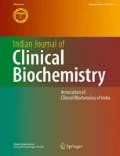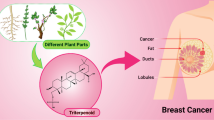Abstract
The present study aimed to investigate the effect of 3,3′-diindolylmethane (DIM) on inflammatory markers, estrogen receptors (ER), progesterone receptors (PR), level of glycoprotein and the mast cell population in 7,12-dimethylbenz (a) anthracene (DMBA) 25 mg/kg b.wt. induced rat mammary carcinogenesis. After 8 weeks of tumor formation, rats had access to an oral administrated with DIM 10 mg/kg b.wt. and DIM@CS-NP 0.5 mg/kg body weight respectively for 8 weeks. The oral administration of DIM@CS-NP 0.5 mg/kg b.wt. suppressed the Cox-2, NF-κB and TNF-α protein expression on DMBA induced rats compared to DIM 10 mg/kg b.wt. The ER/PR levels were increased on DMBA induced rats, treated with DIM@CS-NP 0.5 mg/kg b.wt. reduced ER/PR level as well as glycoprotein and mast cell population than DIM 10 mg/kg b.wt. The result shows that, DIM@CS-NP 0.5 mg/kg b.wt. has the potentially inhibit abnormal levels of inflammatory markers, ER, PR, levels of glycoprotein and mast cell population compared to DIM 10 mg/kg b.wt.





Similar content being viewed by others
Change history
25 May 2021
A Correction to this paper has been published: https://doi.org/10.1007/s12291-021-00981-2
References
Temple NT, Gladwin KK. Fruit, vegetables, and the prevention of cancer: research challenges. Nutrition. 2003;19:467–70.
Luo Y, Wang TT, Teng Z, Chen P, Sun J, Wang Q. Encapsulation of indole-3-carbinol and 3,3′-diindolylmethane in zein/carboxymethyl chitosan nanoparticles with controlled release property and improved stability. Food Chem. 2013;139:224–30.
Blanco E, Ferrari M. Emerging nanotherapeutic strategies in breast cancer. Breast. 2014;23:10–8.
Hu Y, Jiang XQ, Ding Y, Ge HX, Yuan YY. Synthesis and characterization of chitosan–poly (acrylic acid) nanoparticles. Biomaterials. 2002;23:3193–201.
Chuang JY, Yang WY, Lai CH, Lin CD, Tsai MH. CTGF inhibits cell motility and COX-2 expression in oral cancer cells. Int Immunopharmacol. 2011;11:948–54.
Zhao Y, Yang F, Li W, Xu C, Li L, Chen L, et al. miR-29 a suppresses MCF-7 cell growth by down regulating tumor necrosis factor receptor 1. Tumour Biol. 2017;39(2):1010428317692264.
Greten FR, Eckmann L, Greten TF, Park JM, Li ZW. IKK beta links inflammation and tumorigenesis in a mouse model of colitis-associated cancer. Cell. 2004;118:285–96.
Hanahan D, Weinberg RA. Hallmarks of cancer: the next generation. Cell. 2011;144:646–74.
Isabella S, Mirunalini S. Chemotherapeutic effect of 3,3′-diindolylmethane encapsulated chitosan nanoparticles on 7,12-Dimethylbenz(a) anthracene induced mammary cancer—a dose dependent study. New Horiz Transl Med. 2016;3:1–8.
Elzatahry AA, Mohy Eldin MS. Preparation and characterization of metronidazole-loaded chitosan nanoparticles for drug delivery application. Polym Adv Technol. 2008;19:1787–91.
Arulmozhi V, Pandian K, Mirunalini S. Ellagic acid encapsulated chitosan nanoparticles for drug delivery system in human oral cancer cell line (KB). Colloids Surf B Biointerface. 2013;110:313–20.
Welsch CW. Host factors affecting the growth of carcinogen-induced rat mammary carcinomas: a review and tribute to Charles Brenton Huggins. Cancer Res. 1985;45:3415–43.
Laemmli UK. Cleavage of structural proteins during the assembly of the head of bacteriophage T4. Nature. 1970;227:680–5.
Migliaccio AR, Rana RA, Sanchez M, Lorenzini R, Centurione L. GATA-1 as a regulator of mast cell differentiation revealed by the phenotype of the GATA-1low mouse mutant. J Exp Med. 2003;197:281–96.
Yamabayashi S. Periodic acid–Schiff–alcian blue: a method for the differential staining of glycoproteins. J Histochem. 1987;71:565–71.
Choi JS, Cao J, Naeem M, Noh J, Hasan N, Choi HK, et al. Size-controlled biodegradable nanoparticles: preparation and size-dependent cellular uptake and tumor cell growth inhibition. Colloids Surf B Biointerfaces. 2014;122:545–51.
De Jong WH, Borm PJ. Drug delivery and nanoparticles: applications and hazards. Int J Nanomed. 2008;3:133–49.
Idriss HT, Naismith JH. TNF alpha and the TNF receptor super family: structure-function relationship(s). Microsc Res Tech. 2000;50:184–95.
Kumar R, Vadlamudi K, Adam L. Apoptosis in mammary gland and cancer. Endocr Relat Cancer. 2000;7:257–69.
Wang Z, Yu BW, Rahman KM, Ahmad F, Sarkar FH. Induction of growth arrest and apoptosis in human breast cancer cells by 3,3-diindolylmethane is associated with induction and nuclear localization of p27kip. Mol Cancer Ther. 2008;7:341–9.
Pandey M, Prakash O, Santhi WS, Soumithran CS, Pillai RM. Overexpression of COX-2 gene in oral cancer is independent of stage of disease and degree of differentiation. Int J Oral Maxillofac Surg. 2008;37:379–83.
Subbaramaiah K, Dannenberg AJ. Cyclooxygenase 2: a molecular target for cancer prevention and treatment. Trends Pharmacol Sci. 2003;24:96–102.
Pandi M, Manikandan R, Muthumary J. Anticancer activity of fungal taxol derived from Botryodiplodia theobromae Pat., an endophytic fungus, against 7,12-Dimethylbenz (a) anthracene (DMBA)-induced mammary gland carcinogenesis in Sprague Dawley rats. Biomed Pharmacother. 2010;64:48–53.
Kim YH, Kwon H-S, Kim DH, Shin EK. 3,3′-Diindolylmethane attenuates colonic inflammation and tumorigenesis in mice. Inflamm Bowel Dis. 2009;15:1164–73.
Buijs JT, Cleton AM, Smit VT, Lowik CW, Papapoulos SE. Prognostic significance of periodic acid-Schiff-positive patterns in primary breast cancer and its lymph node metastases. Breast Cancer Res Treat. 2004;84:117–30.
Coussens LM, Raymond WW, Bergers G, Laig-Webster M, Behrendtsen O. Inflammatory mast cells up-regulate angiogenesis during Squamous epithelial carcinogenesis. Genes Dev. 1999;13:1382–97.
Laverias G, Danilo C, Mercier I, Daumer K, Capozza F. Role of cholesterol in the development cholesterol in the development and progression of breast cancer. Am J Pathol. 2011;178:402–12.
Telang NT, Suto A, Wong GY, Osborne MP, Bradlow HL. Induction by estrogen metabolite 16-alphahydroxyestrone of genotoxic damage and aberrant proliferation in mouse mammary epithelial cells. J Natl Cancer Inst. 1992;84:634–8.
Deepalakshmi K, Mirunalini S. Efficacy of Pleurotus ostreatus (Jacq. Ex Fr.) P. Kumm., on 7,12-Dimethylbenz (a) anthracene induced mammary carcinogenesis in female Sprague-Dawley rats. New Horiz Transl Med. 2016;3:73–82.
Author information
Authors and Affiliations
Corresponding author
Ethics declarations
Conflict of interest
The authors declare that there are no conflict of interests.
Rights and permissions
About this article
Cite this article
Isabella, S., Mirunalini, S. & Pandiyan, K. 3,3′-Diindolylmethane Encapsulated Chitosan Nanoparticles Accelerates Inflammatory Markers, ER/PR, Glycoprotein and Mast Cells Population During Chemical Carcinogen Induced Mammary Cancer in Rats. Ind J Clin Biochem 33, 397–405 (2018). https://doi.org/10.1007/s12291-017-0701-2
Received:
Accepted:
Published:
Issue Date:
DOI: https://doi.org/10.1007/s12291-017-0701-2




